Politicisation of culture
Politicality is increasingly hard to avoid in various spheres of public activity and this includes, especially in recent years, the cultural sector. All the more in activities done by a vital state institution propagating contemporary art. It is with ease that one may, intentionally or not, engage in a widely understood ideological debate, even if it is in the area of early art exposition and promotion. Examples of discussions on attempts to reform Dutch museums in the context of decolonialisation discourse[1], or objection towards the way in which Caravaggio’s exhibition was promoted in Utrecht[2], reflect the tendencies developing in western societies. However, if one was to encourage a worldview debate to provoke a discussion, with full awareness of that fact, they need to be prepared for a fierce polemics at best.
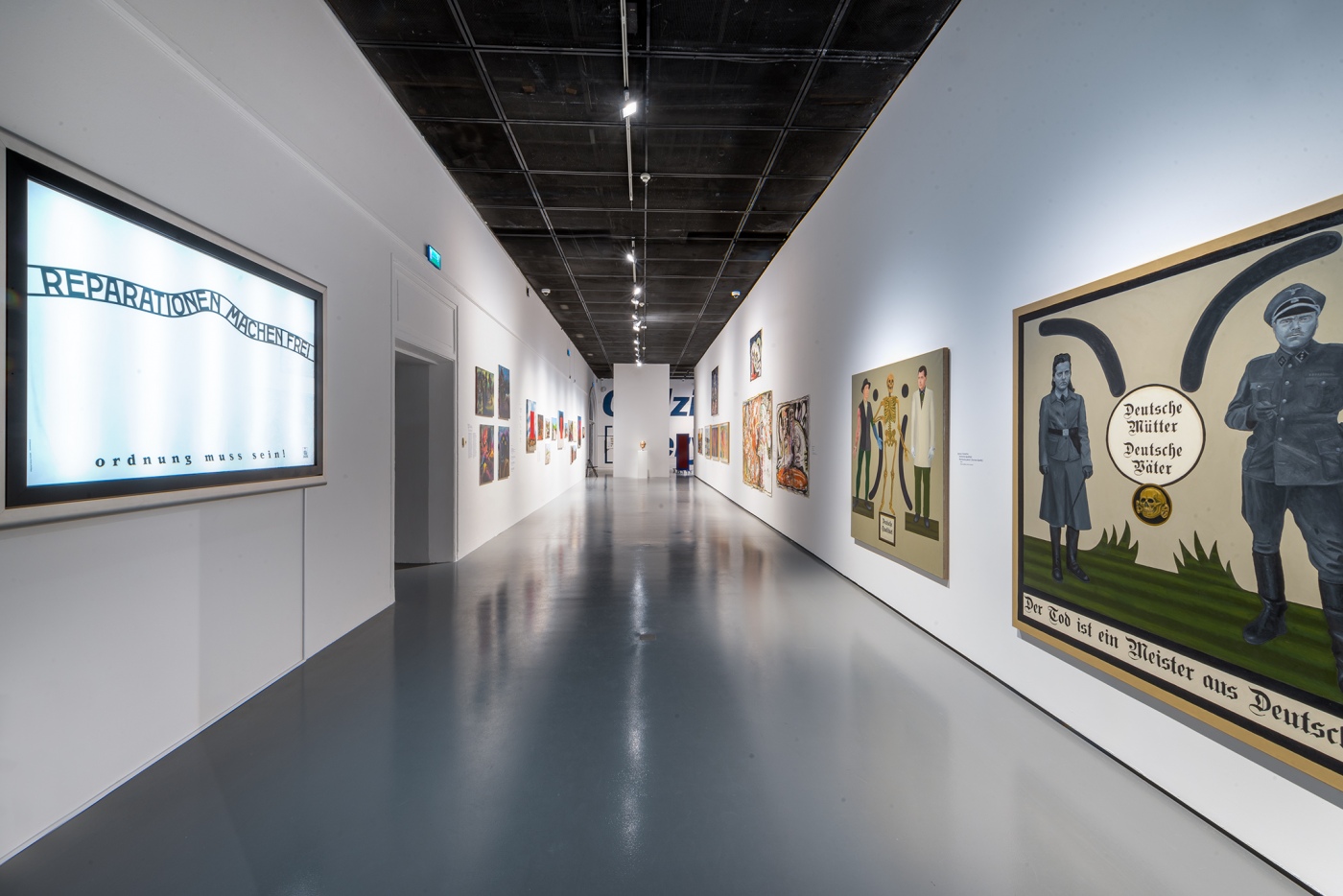
Political Art, Ujazdowski Castle Centre for Contemporary Art, view at the exhibit
The exhibition at Ujazdowski Castle Centre for Contemporary Art explicitly entitled “Political Art” have become the eye of the storm with winds of criticism howling around it. People responsible for organising the exhibition are two curators, PhD Piotr Bernatowicz, director of Ujazdowski Castle Centre for Contemporary Arts and a Norwegian, Erik Lundberg, running Læsø Kunsthal gallery. At the outset, one may be tempted to say that the exhibition ratings are dominated by critical voices. Nevertheless, in most part they are not aimed at what effect the implementation of curators’ idea was carried out with or at artistic value of presented works, but rather at the curators’ ideological attitude. It would seem consistent with the exhibition’s premise – a political one – within which discussion is meant to take place and this particular sphere usually arouses strong emotions.
It is well seen when art becomes an area where various approaches are confronted; however, this time it is a ground for escalating conflict in a society that has already been heavily polarised on different matters. Let the above observation be treated as an introduction to the analysis of a general discourse surrounding this controversial exhibition. Since the crux of the discussion lies in the worldview, it is necessary to reach beyond its visual aspect and take a closer look at its reception.
On the basis of recurrent arguments and accusations as much can be inferred, exclusively by analysing the audience. Naturally, it involves a relatively tight group since statistical tools should be engaged to obtain at least seemingly accountable view of wider response to the exhibition. The reception concerns mainly journalists specialised in commenting diverse cultural phenomena or simply being experts in their assessment of contemporary socio-political tendencies who are able to stand by one side of a conflict. In addition, one should inspect attitudes of organisations and institutions that voiced their opinion in open letters sent to the director. These are declarations in sufficient measure conveying tensions present in the public debate.
Boundaries of artistic expression
To begin with, a significant part of opinions about the exhibition preceded its opening and were centred around inviting two controversial Scandinavian artists, Dan Park and Uwe Max Jensen, to take part in it. Drawing the attention to those creators can be seen not only in texts published in the press, but in protest letters as well. The event that initiated the chain of exhibition’s critical reception was the protest in front of Ujazdowski Castle Centre of Contemporary Art, described by organisers as “National fascism promotion: swastika included”. On the opening day, even before the private viewing started, banners with slogans such as: “the state promotes fascism”, „i.a. GLIŃSKI, you fascist” and „DAN PARK WE DON’T WANT FASCIST ART HERE”[3] could be seen on site. The following day, a female activist popularised by the media, called “grandma Kate” (Katarzyna Augustynek), sprayed “down with fascism” at the entrance to CCA and an attempt was made by the police to stop her from doing so[4]. The outrage followed by the possibility to confront the exhibited works is related to the activity of both guests, though most attention is devoted to Dan Park.
The Swedish, Malmö-based artist focuses on the social critique, combining graphics, site specific installations and, broadly speaking, “intervention art”[5]in his works. Questions raised by him are difficult and are presented in ambiguous way; equipped in his ideas, he trespasses outside the gallery context, for which he stood trials on numerous occasions. Starting from 1998, due to display of banned symbols belonging to totalitarian regimes: wearing a jacket with swastika on it in a public place. Yet another media-broadcasted Park’s action was putting a can labelled “Zyklon B” and forming a swastika out of beads in a Jewish commune, near Malmö synagogue (2009) – a deed for which he was eventually cleared of charges. Additionally, a considerable uproar was caused by the posters he stuck in public space, especially the one with Adolf Hitler’s head wearing a crown of thorns saying: “He too died for our sins”. Not to mention Anders Breivik’s portrayals – one saying “free Breivik” and the other – with the name of a famous clothes brand, LACOSTE, at the bottom and a slogan: “unconventional style” at the top (this one is to be found at the exhibition)[6]. The other topic evoking strong feelings is connected with Dan Park’s posts on Holocaust in social media as well as critical remarks about ethnic and religious minorities (black, Romani and Muslim).
It was on account of said comments that in 2018 he was charged with incitement to hatred. Undisguised membership of PEGIDA, a group criticising migrants from the Middle East[7], completes his image which the artist consequently maintains.
On the other hand, Dane Uwe Max Jensen, steadily creates the aura of controversy around his person if only through his membership of Stram Kurs (English: Hard Line), a radical right-wing party. Jensen’s creative activity is focused on performance art and he came to be known to wider public urinating at two artistic installations by Olafur Eliasson. In 2005 that was “Waterfall” in ARoS, and in 2017 – “Den trekantede himmel” in the sculpture park of Kunsten museum in Aalborg. However, these were his Islam-hitting caricatures of Muhammad and a painting “playing ball with Koran” along with a “ceremonial burning of Koran” act that elicited even more outrage[8]. This last activity took place near a Malmö mosque and as for his motivations, Jensen explains he wanted to show that despite ever-increasing political correctness Islam in Sweden can still be criticized and laughed at[9]. Not to mention the performance delivered as a part of exhibition’s private viewing, taking place at the Ujazdowski Castle’s courtyard. Firstly, the performer weaves a considerably large banner that was used by the Confederates during the American Civil War, and it represented a group of states in the South. Since, nowadays, the Confederates are associated with slavery which was substantially more far-reaching than in the North, as his next act, the artist strips naked and lubricates his body with black paint to imitate dark skin. The words I can’t breathe he cries thereafter, combined with wallowing on the ground, were interpreted as a reference to tragically deceased George Floyd who died during an intervention as a result of being pressed to the ground by a policeman[10].
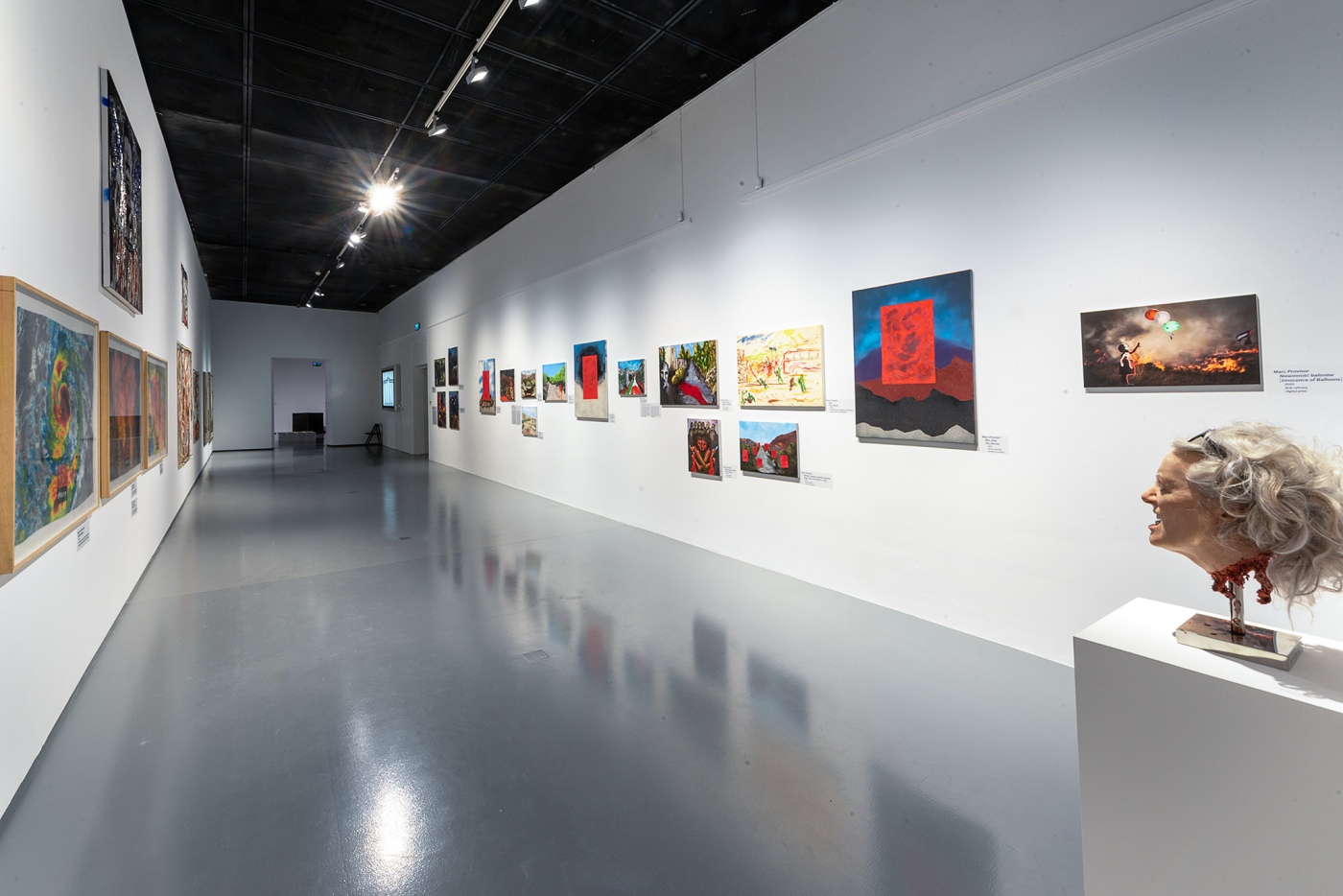
Political Art, Ujazdowski Castle Centre for Contemporary Art, view at the exhibit
Due to the character of artistic activity presented above, the very information about these artists’ participation in the exhibition triggered a response of institutions and organisations disturbed by this fact. Anti-fascist Year[11] posted a statement on its website where said artists are told to be using racist and anti-immigration rhetoric[12]. The objection to presenting the works of Park alone was raised by various Jewish organisations’ representatives, including Jewish Community of Warsaw, director of the Warsaw Ghetto Museum or “Children of the Holocaust” Association. In the open letter to director Piotr Bernatowicz, they pointed out the anti-Semitic motifs present in his works and ideas expressed in social media. The letter declared understanding towards creative freedom and voicing one’s worldview. Nevertheless, it claimed that the artist promotes intolerance and hatred, which was further on contrasted with Poland’s tragic history due to Nazi activity – the ideology of whom Park was assumed to represent. The representatives of Jewish organisations also stated that inviting the artist to the exhibition was a deliberate action aimed to spark controversy[13].
The disagreement with the display of Park’s works was expressed by a group of CCA workers in their statement published on the exhibition day. Similarly to the institutions listed above, they reject the promotion of an artist representing radical views and using in his works symbols that refer to the ideology dramatically harmful to our nation in the past[14]. Yet more astonishing is the dissenting voice of Dorota Krawczyk-Janisch, entrusted with watching over the artwork created by Krzysztof Jung whose painting “Russia 917 – 1951” was presented on the exhibition. Although the piece belongs to the Castle’s collection, she deemed it reprehensible to put it beside the works of artists who, in her opinion, use hate speech, promote racist and anti-Semitic content[15].
The right to art criticism
Piotr Bernatowicz refutes accusations of promoting neo-Nazi ideologies by Park and states that the regimes symbols he uses are meant to be the Swedish politics’ critique. Addressing allegations of anti-Semitism made against the artist, the curator notices that in fact Park stigmatises racism, should we define the term as privileging a minority over the rest of the society in his country[16]. Both works and comments on social media authored by Park as well as Jensen, the director considers to be an artistic provocation characterised by irony[17]. He refers here to the poster that depicts Hitler wearing a crown of thorns which – in curator’s opinion – is not an attempt to merely glorify this felon but rather a starting point to reflect upon making him an icon of all evil, belittling the guilt of others. He also comments on the events that happened in Jewish Community in Malmö, recognising that, in spite of appearances, their purpose was to draw attention to ignorance towards increasing attacks on this group. Moreover, Bernatowicz acknowledges Park as an excluded artist whose freedom of expression is limited and he compares him to a Belarussian artist named Aleś Puszkin, taking part in the exhibition as well, who is regularly sentenced by decisions of the court[18].
According to the director, these controversial pieces are not only meant to shock, but also to raise questions about the freedom of creative expression. He emphasises that works of art should not be understood literally and they should be distinguished from a political statement. The ethical boundary which constitutes a barrier in formulating the artistic message is, in Bernatowicz’s view, direct and physical violence [19]. Elaborating on the intentions behind „Political Art” organisation, the director speaks about testing the tolerance limits and opposing various dogmas through the presentation of socio-politically engaged artists’ works. The purpose of the exhibition is to create “a platform to express art and a space for rebel artists[20].
Additionally, the curator’s intentions are specified in the description on the Warsaw CCA’s website where one can find a mention of a fight against political correctness and the so called cancel culture. In broader terms, it involves an attempt to confront hegemony of the new political order intended to restrict democratic values[21]. Bernatowicz indicates that the contemporary art world is dominated by the left-wing mindset with critical voices being considered both censorship as well as hypocrisy of proclaiming liberal ideas with simultaneous effort to censor different works. At the same time, he points to the fact that focusing on controversies related to just a few artists, caused the involvement of the other 26 artists – coming from different cultures and referring to other dimensions of reality – in the exhibition to be diminished[22]. The director proceeds to talk about hegemony of the left-wing concepts relevant to art institutions. He notes how certain artists are promoted, yet they are engaged in social matters of and critical about one particular worldview, with some topics unmentioned[23]. „Political Art” co-author, Jon Eirik Lundberg, also refutes the allegations regarding the promotion of racism, in a similar way emphasising the motivation to fight for free speech and equal democratic rights. On the other hand, two artists participating in the exhibition, Marc Provisor and Hans von Hornsleth, recognise its controversial and revolutionary character, yet believing that the audience should face it and art gives the right to express opinions in this manner[24].
Strategy of provocation and freedom of speech
Nevertheless, the critics believe the controversies surrounding the exhibition to be a carefully calculated strategy devised by curators to reassure the thesis of the latter about the left-liberal groups’ extreme approach that does not allow the other side to voice their opinion[25]. According to Jan Kuśmirski, apart from the tension over the exhibition, most of the presented works are not formally attractive. Works of Park and Jensen stand alone in a negative way and they should be displayed in an ethnographic museum at most, as a public sentiment expression. In his view, the “besieged fortress” mechanism has been used here in the contexts of Poland and right-wing world whereas political correctness, understood as a threat to free speech, has become an overused cliché. Such ambitions clearly have a purpose of making Poland “centre for conservative art” and push us further away into an artistic margin[26]. Szabłowski considers reactions preceding the opening of the exhibition as frantic, reflecting the division in art to left and right side, with the latter one being represented by the present CCA director. Paradoxically, such action is supposedly beneficial for curators’ intentions behind “Political Art”. As Witold Mrozek says, the names of these two artists greatly helped in promoting the exhibition. Without them, it would have been just another exposition dealing with not particularly novel subject of artists being prosecuted for their views[27].
Paweł Klimczak discredits the director’s argument about using provocation and irony as a means to draw attention to a specific problem. Even if the aforementioned artists had such intentions, they have sunk into this ideology to the point where a boundary between the choice of style and ideological stance has become blurred. Furthermore, as he observes, committed membership of extreme right-wing political party could hardly be classified as an artistic act[28]. In Karol Sienkiewicz’s view, curators conceal their radical content under false pretences of free speech being suppressed by the political correctness terror. “Political Art” appropriates definitions of the other side and turns liberal ideas around, as exemplified by excluded artists’ category use[29]. In one of the texts, the allegation of intellectual dishonesty towards organisers is directly articulated: they attempted to prove, in a political exhibition nonetheless, how they are free from politics and care only about objective truth to be told. Seeing Piotr Bernatowicz’s declaration on the diversity of presented art, the contrasting juxtaposition of political radicals and actual victims of ideological extremism as well as authoritarian regimes was noted[30]. Among them, one can find creators directly threatened by Islam fundamentalists – artists such as Agnieszka Kolek and Lars Vilks, or Farnoush Amini who grew up in Iran during the Islamic Revolution, and Tasleem Mulhaal, a Yemeni escaping repression. In addition, there is a Belarussian artist, Aleś Puszkin charged with court sentences multiple times and permanently persecuted by Lukashenko’s regime. This „conglomerate” includes Kristian von Hornsleth[31], who has become more widely recognised due to “Hornsleth Village Project”, documented in a series of portrait photographs on display at the exhibition[32].
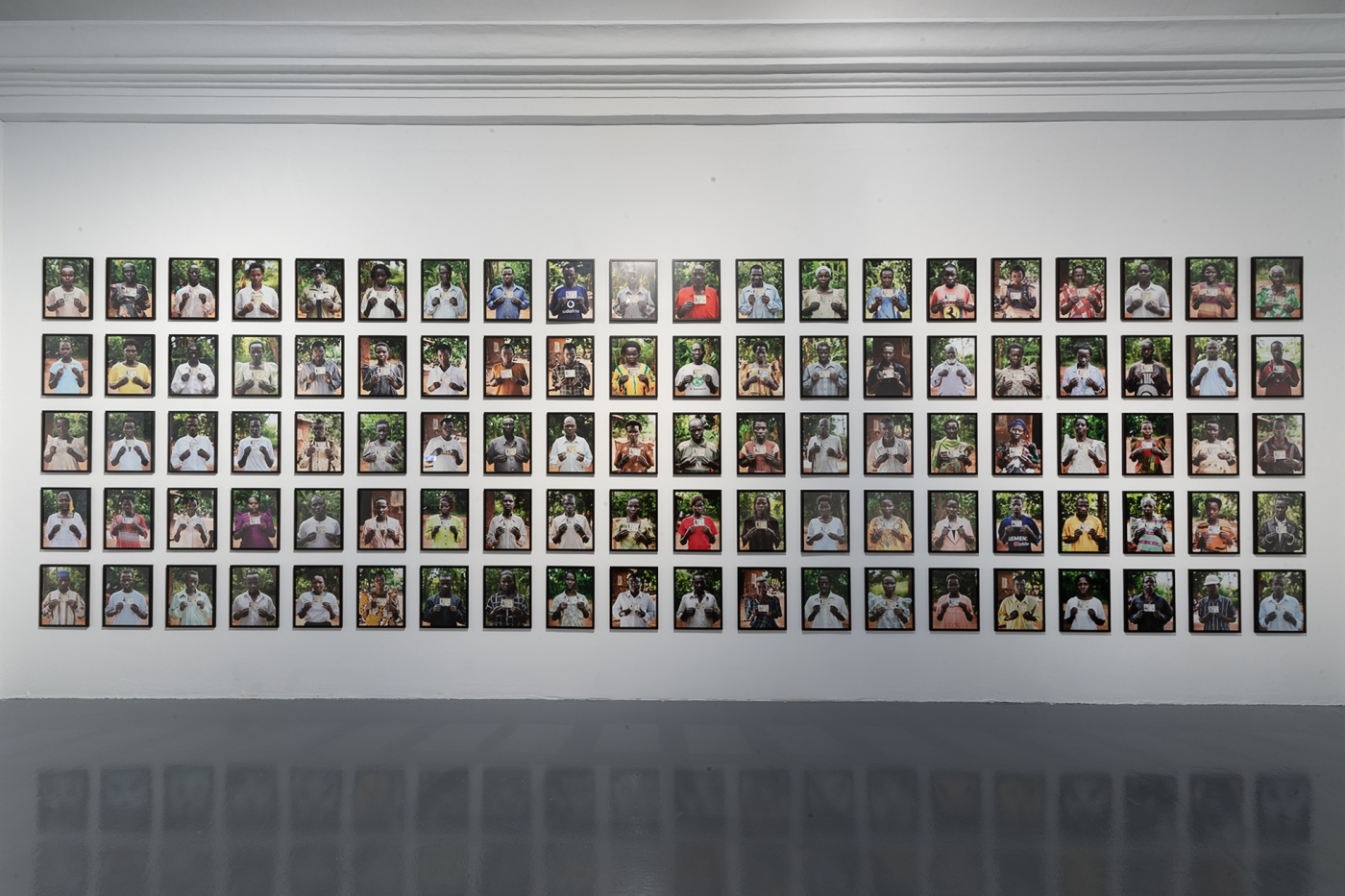
Kristan von Hornlseth, Hornselth Village Project
In critics’ view, this pluralism of artistic expression is negatively complemented by a few Polish artists who would follow the so called “national art” programme. They would introduce to the exhibition a critical commentary towards LQBT+ community, such as in the case of „Tonfa” by Jacek Adamas or towards Polish-German relations referred to in large format canvas by Ignacy Czwartos. The ultimate result of said juxtaposition would be legitimisation of both curators’ radical right-wing views. Though, the most heavily criticised in this context are actions of Piotr Bernatowicz. The reviewers claim that his conformist attitude serves the current government agenda and does not purely express rebellion towards left-wing dominance in culture[33]. Some see the exhibition simply as a form of manifesto unveiled by the CCA’s director[34], strenuously focusing on propagating right-wing values in art, influencing the perspective through which “political art” in question is perceived[35]. It is argued that freedom and pluralism echoing from the director’s words are a part of right-wing rhetoric against minorities[36]. As a consequence, a concept for exhibition is present in the context of wider changes that have been taking place in recent years in Polish cultural institutions, which would lead to national radicalism in this matter[37].
A different perspective
On the other hand, there were some opinions of the authors attempting to capture the main idea behind the exhibition from a different angle: starting from the premise that art – regardless of the century or its current – had a political character and it includes masters of classical art as well. Mariusz Baryłka believes that pieces authored by most disedifying Scandinavian artists are not interesting enough to analyse them in depth. Distancing himself from the controversial atmosphere, he states that the majority of presented works is similar to reportage photography with respect to their subjects and formal expression. Unlike others who did not mention it, he distinguishes a small photo series entitled “Potency” by Maria Kleivan where the author shows her few-month-old baby in uniforms, resembling the ones worn by historical dictators from various countries.
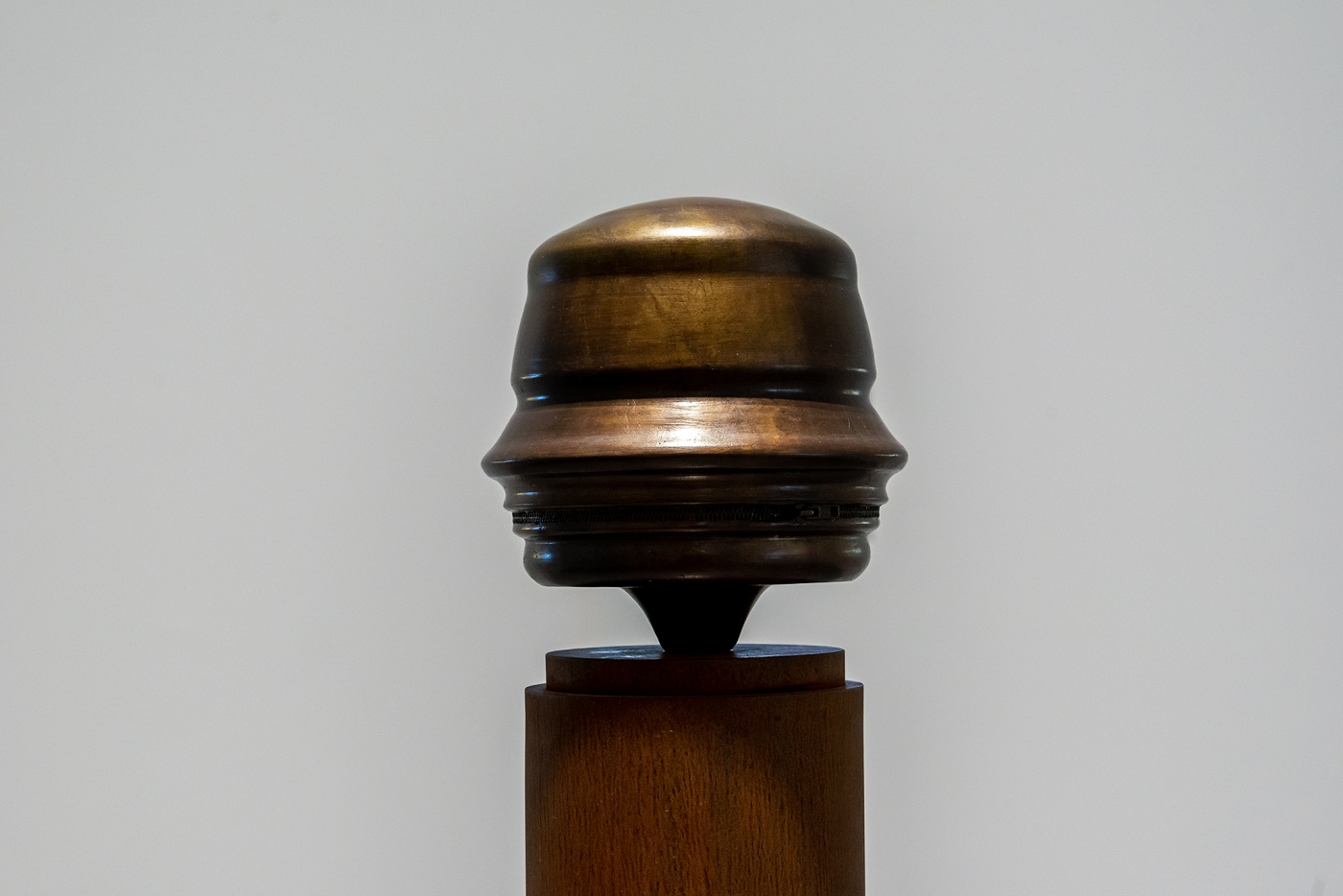
Emma Elliot, Spin-head, fot. Daniel Czarnocki
Furthermore, he writes about Emma Elliott’s “Spin-head” sculpture, a travesty of a famous piece “Profilo continuo del Duce” by futurist Renato Bertelli. However, the final conclusion being that though the exhibition is important, the problems mentioned there are merely signalled and the way they are presented is a tentative proposal that requires extension[38]. Piotr Kosiewski also believes that there is a potential for more profound reflection but it results from the way – intentional to some degree – in which the contemporary ideological dispute in Poland was presented. The exhibition mirrors the concerns of communities that feel alienated from the possibility to express themselves in the art world and much can be said about the government’s current cultural policy[39].
The exhibition content can be perceived dissimilarly as exemplified by Filip Memches. On the one hand, he understands the outrage over artists using artistic provocation in Nazi crimes themes. On the other, he sees analogy between such action and similar strategies in left-wing circle, therefore he refers to “Tag” video [original Polish title: “Berek” – translator’s note] by Artur Żmijewski. The artist used strong, provocative means of expression in order to address the matter as serious as genocide having taken place in concentration camps. At that time, the museum in Berlin finally decided to exclude the work – given its form – from an exhibition devoted to Polish-German relations. This action was objected to by the curator of exhibit’s Polish section as well as journalists from Gazeta Wyborcza. Yet even more hyped was the case of “Passion” [original Polish title: “Pasja”- translator’s note], an installation by Dorota Nieznalska, where the artist decided on an analogous artistic strategy aimed to raise controversy. It is worth mentioning that Piotr Bernatowicz used a similar argument in response to controversies about the exhibition[40].
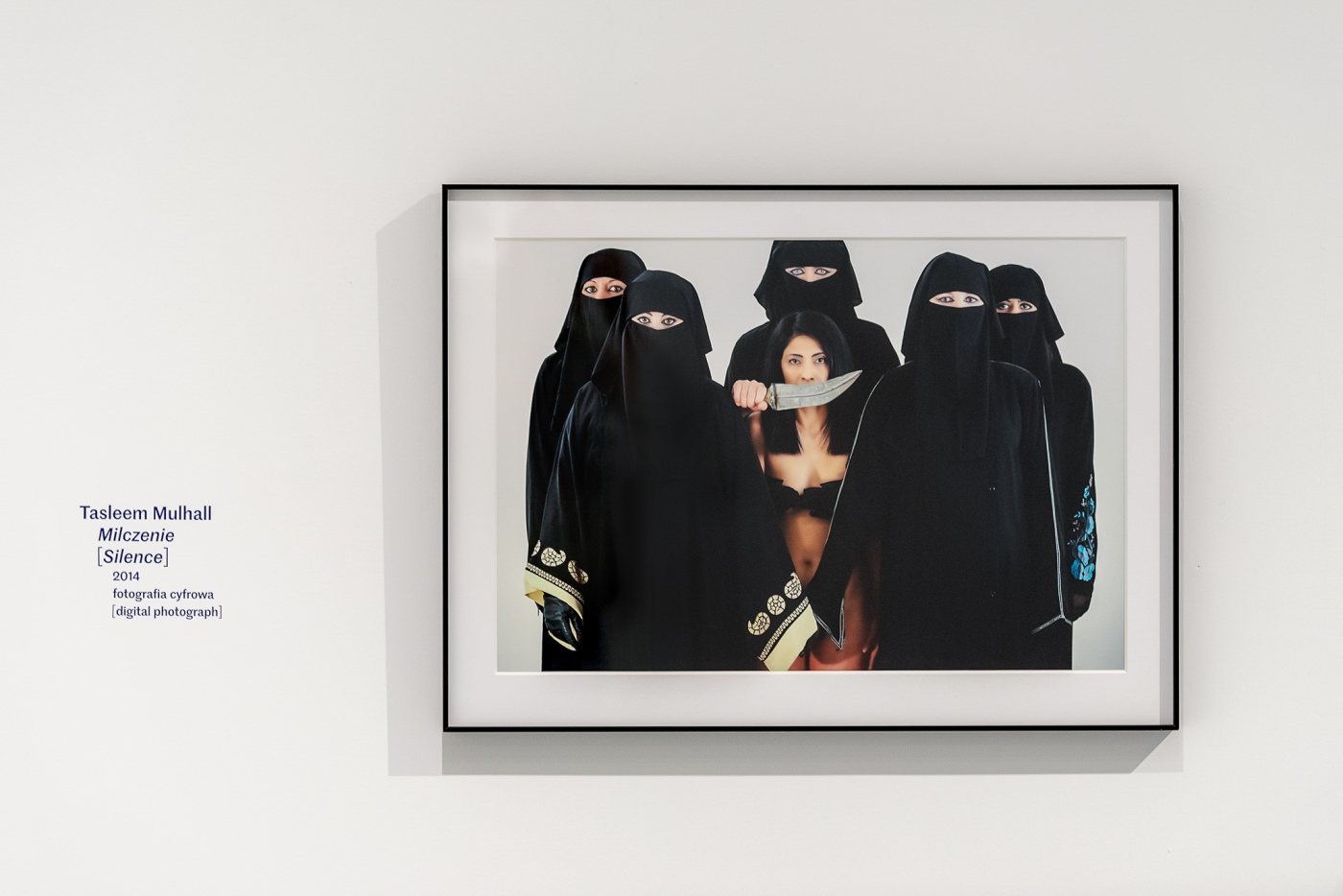
Tasleem Muhalli, Silence, fot. Daniel Czarnocki
Memches does not believe in previously mentioned pluralism to be superficial, especially, if one was to venture beyond the creations critical of Islamic fundamentalism, such as “Stoned” sculpture by Tasleem Mulhall. He is also the only one who mentions Seamus Moran’s installation „Give me the child” and its commentary on paedophilia in the Catholic Church[41].
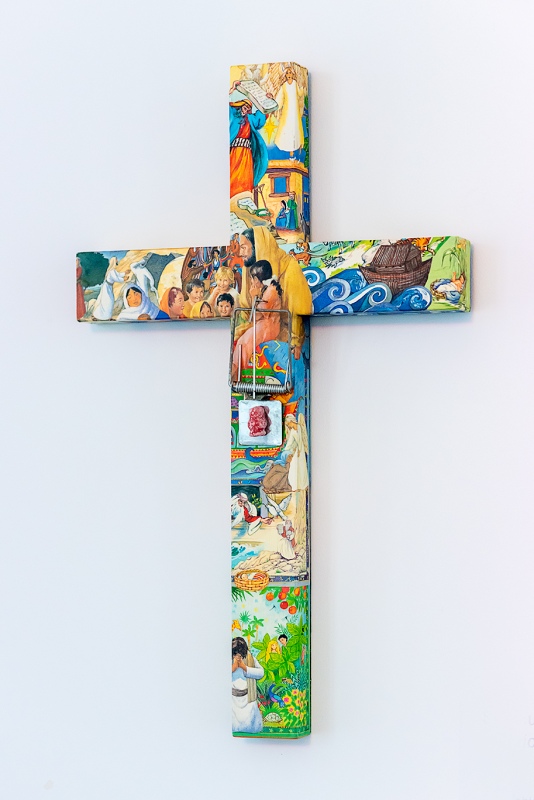
Séamus Moran, Give me the child, fot Daniel Czarnocki
Another noteworthy review should be mentioned since it includes Max Jensen’s works who, apart from performance art, employs different artistic forms as well. Considering “In the Ghetto” collage, the creative contrasts Elvis Presley’s head with a figure of a soldier wearing Nazi uniform, and thus comments on the absurd interpretation of his works as being racist.
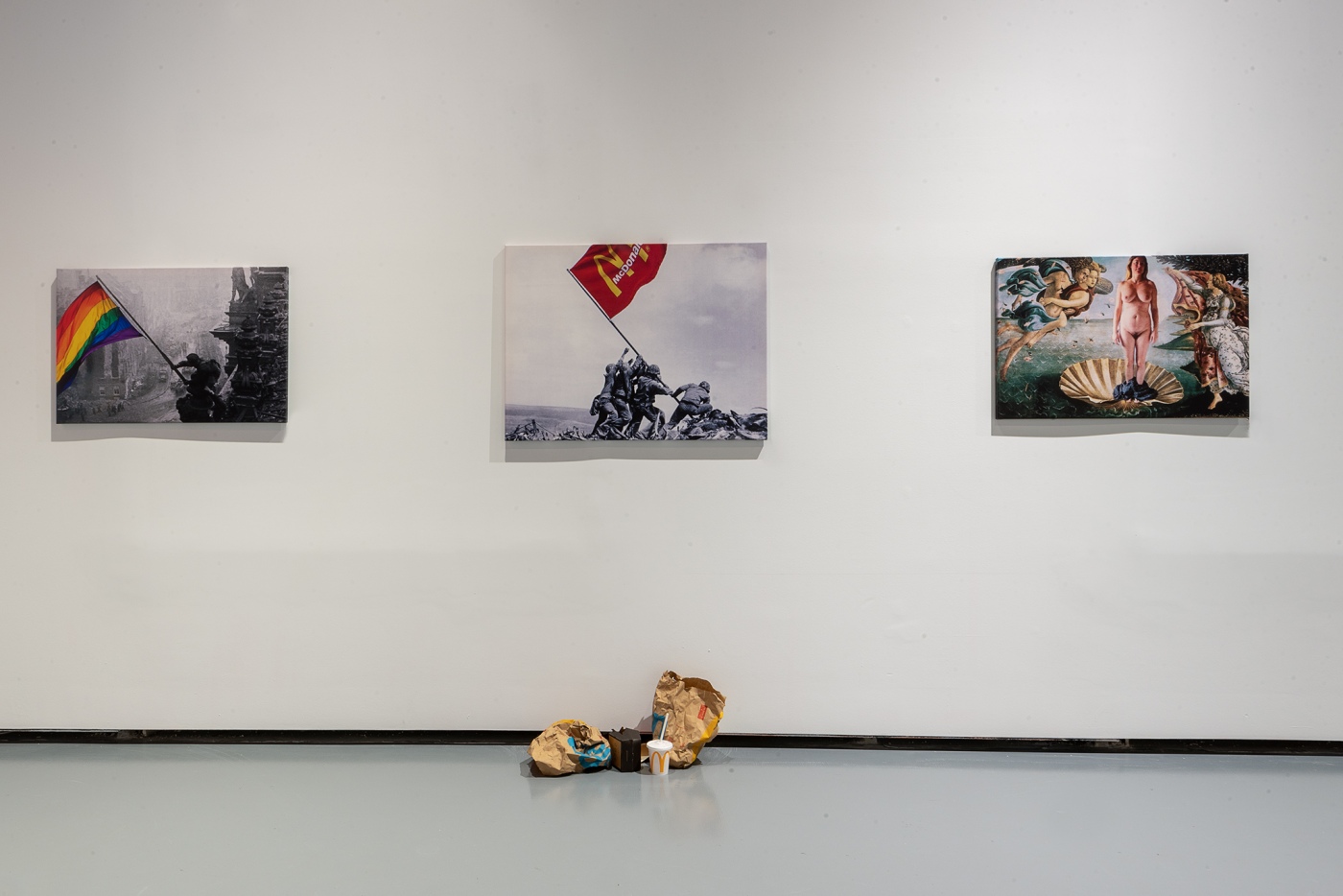
Max Jensen, Rainbow Warrior. We fought for this, fot. Daniel Czarnocki
“Rainbow Warrior. We fought for this” is a photomontage showing the moment of capturing Berlin, with victory banner replaced with a rainbow flag affiliated with LGBT+ communities. The author of the article urges readers to see the work not as much as an attack on sexual minorities but rather an attempt to reflect on the nature of violent revolutions. Addressing the outrage over „”Political Art”, he makes quite an accurate commentary on the reaction to Maurizio Cattelan’s sculpture “La nona Ora” which was received by Polish audience in an extremely different way than anywhere else[42].
Freedom of expression
It is certain that the discourse concerning “Political Art” reflects considerable tensions and divisions in a sphere of culture and beyond, in Polish society. Nevertheless, the fact that such an exhibition could be organized, without legal consequences and the fear of it being closed, testifies to a relative freedom of expression through art. Regardless of the extent to which it really follows assumptions present in the current government’s official policy, one can arrive at this conclusion once a comparison to other European countries is made, including Scandinavian countries that are significant in proposed exhibition narrative. Naturally, justifying artists’ all activities with the right to use unrestricted forms of expression, all the more purposefully fluctuating on the boundary between artistic provocation and blatant political activism, is highly debatable. Though, without a doubt, there are themes so sensitive from socio-political perspective that it would seem an impossible endeavour to speak about them freely at galleries of major institutions in many other, seemingly tolerant countries.
In line with dominant voices of objection, one ought to agree that irrespective of actual curators’ intentions, the exhibition was far from being neutral. Many topics were discussed from various perspectives, but every exhibition – especially the one with ambitions of starting a political discourse – is organised with certain motives in mind and this cannot be avoided. The comments explaining assumptions guiding the exhibition clearly point to the specific ideological undertone. The choice of phenomena that curators try to confront with in „Political Art” and the selection of artists who are asked to raise these issues are inextricably connected with presenting their curatorial vision. With this in mind, the impossibility to achieve pluralism has been an inseparable part of every exhibition that dealt with socio-political problems, notwithstanding a ruling political party. It is a result of worldview attitude represented by both curators and artists. There were a great many of exhibitions surrounded by controversies, polarisation manifested itself and attempts of verbal, legal or even physical interventions were made. This enterprise to break the paradigm, dominating in the world of exhibitions in recent years, could be judged in more than one way. And although one can critically approach the presentation of radical creative stances that strike at particular groups, free expression exists as long as the other side has a possibility to form judgments and create its very own, alternative narration in the field of art.
[1]This institutional decolonisation is supposedly attained through hiring a specified percentage of people of non-European descent in museums. Stedelijk Museum obliged to „address and cancel institutional racism” by allocating at least 50% of its budget for non-Western artists’ works in 2021-2024.
https://www.theartnewspaper.com/2020/07/06/decolonising-museums-the-new-network-opening-up-the-diversity-debate-in-the-netherlands. Whereas, upon opening the “Slavery. 10 people, 10 stories” exposition, Rijkmuseum simultaneously added over 70 labels to items at a permanent exhibition that date back to the times when colonial power of the Netherlands was being built; the exhibit itself is associated with the system of slavery.
https://www.rijksmuseum.nl/en/whats-on/exhibitions/rijksmuseum-and-slavery.
Yet another step to implement the process is to remove the expression “The Dutch Golden Age” from museum halls, e.g. in the context of room naming. The name of Amsterdam Heritage Museum wing has been altered from “the Dutch in Golden Age” to “Group Portraits from the 17th century”.
https://www.smithsonianmag.com/smart-news/amsterdam-museum-will-no-longer-use-term-dutch-golden-age-180973140/
Moreover, in line with restitution of losses resulting from colonial expansions, directors of Rijksmuseum and Tropenmuseum in Amsterdam initially supported the legal project according to which 100 000 pieces of art are to be returned.
https://theswaddle.com/dutch-museums-promise-to-return-100000-items-looted-from-former-colonies/
Furthermore, ethnological museum in Berlin is negotiating legal formalities related to returning hundreds of the Benin Bronzes; they were shipped from Nigeria as a result of colonial politics. The museum insists on British Museum in London to do the same. https://www.theguardian.com/artanddesign/2021/mar/23/berlins-plan-to-return-benin-bronzes-piles-pressure-on-uk-museums
[2] Due to the promotion of „Utrecht, Caravaggio and Europe” exhibition, Centraal Museum decided to hang reproductions of pieces presented at the exhibition at a few buildings’ facades. The petition was submitted to the city council but, in time, DENK Muslim party started opposing the idea by expressing their doubts about financing the display of religious-themed reproductions from the city budget. Eventually, as a consequence of increasing stress on promotion, secular-oriented works were chosen.
https://www.ad.nl/utrecht/partijen-vinden-uitsluiten-christelijke-taferelen-op-flatgevel-zelfcensuur~adc03ff9/
[3]Dawid Dróżdż, Protesty podczas otwarcia wystawy w CSW Zamek Ujazdowski. "Państwo promuje faszyzm" (Protests during the opening of the exhibition in Ujazdowski Castle Centre for Contemporary Art. “City promotes fascism”), Gazeta Wyborcza, 27.08.2021
[4]Skandal o którym mówi Warszawa. Babcia Kasia nie wytrzymała)
https://www.o2.pl/informacje/skandal-o-ktorym-mowi-warszawa-babcia-kasia-nie-wytrzymala-6677493127908192a, [Access date: 19.01.2022].
[5] Sources for this particular creative activity should be sought in works of Joseph Beuys, the author of a famous quote saying that “every man is an artist”. It is worth mentioning “social art studio”, a unit working within University of Bialystok structures that brings together theoreticians and practitioners active in widely understood socio-civic activism. This subject is elaborated on in: Pogranicze. Studia Społeczne, vol. 26/2015, see especially - Uliza Urwanowicz Rojecka, Od sztuki site-specific po sztukę partycypacyjną. Sztuka zaangażowana – wybrane współczesne teorie i praktyki artystyczne.
[6] Dawid Drożdz, Brunatnie Niepoprawni, Gazeta Wyborcza, 23 sierpnia 2021; „Platforma do wyrażania sztuki", czy "państwowa promocja faszyzmu"? Kontrowersyjna wystawa w Warszawie, 04.09.2021, https://kultura.onet.pl/wiadomosci/wystawa-w-cws-prace-dana-parka-wywoluja-kontrowersje/zbvdtz0, [Data dostępu: 19.01.2022]; Aleksander Hudzik, Memy z Breivikiem i parodiowanie śmierci George'a Floyda, czyli skrajna prawica pokazuje się w CSW, 31.08.2021,
https://www.newsweek.pl/kultura/skandaliczna-wystawa-w-warszawskim-csw-zamek-ujazdowski/0ex0s8r, [Access date: 19.01.2022].
[7Maja Heban, Dan Park to rasista z wyrokami. Pytamy dyrektora CSW, czy to odpowiedzialne go wystawiać, 25/08/2021,
https://noizz.pl/kultura/dan-park-w-csw-dyrektor-i-kurator-komentuje-spor-o-skazanego-rasiste/2jrr5mt, [Access date: 20.01.2022]
[8] Dawid Drożdz, Brunatnie Niepoprawni, Gazeta Wyborcza, 23.08.2021
[9] „Platforma do wyrażania sztuki", czy "państwowa promocja faszyzmu"? Kontrowersyjna wystawa w Warszawie, 4.09.2021
https://kultura.onet.pl/wiadomosci/wystawa-w-cws-prace-dana-parka-wywoluja-kontrowersje/zbvdtz0, [Access date: 20.01.2022].
[10] Aleksander Hudzik, Memy z Breivikiem i parodiowanie śmierci George'a Floyda, czyli skrajna prawica pokazuje się w CSW, 31.08.2021,
https://www.newsweek.pl/kultura/skandaliczna-wystawa-w-warszawskim-csw-zamek-ujazdowski/0ex0s8r, [Access date: 19.01.2022].
[11] Anti-fascist Year is a common name for multiple artistic, cultural and social activities which are to take place across the whole country between September 1, 2019 and May 8, 2020, that is, between the 80th anniversary of the Second World War outbreak and the 75th anniversary of its end. A number of public bodies joined the Anti-fascist Year organisation. Cultural institutions, non-governmental organisations, social movements, female and male activists are networking and creating platforms for their activity. Zaczyna się Rok Antyfaszystowski, 02.09.2019,
https://krytykapolityczna.pl/kraj/1-wrzesnia-8-maja-rok-antyfaszystowski/, [Access date: 23.01.2022].
[12]https://rokantyfaszystowski.org/en/stanowisko-roku-antyfaszystowskiego-w-sprawie-wystawy-sztuka-polityczna-w-centrum-sztuki-wspolczesnej-zamek-ujazdowski/, [Access date: 18.01.2022].
[13]The open letter from representatives of Jewish communities to Mr Piotr Bernatowicz, 27.08.2021
Patryk Strzałkowski, Skazany za mowę nienawiści artysta w warszawskim CSW. Organizacje żydowskie protestują,https://wiadomosci.gazeta.pl/wiadomosci/7,114883,27499501,skazany-za-mowe-nienawisci-artysta-w-warszawskim-csw-organizacje.html, [Access date: 17.01.2022].
[14]Barbara Kwiatkowska, Warszawa. Artysta niechciany. "Wykorzystuje symbole nazistowskie", 27.08.2021, https://wawalove.wp.pl/warszawa-artysta-niechciany-wykorzystuje-symbole-nazistowskie-6676762038803296a, [Access date: 21.01.2022].
[15] Gazeta Wyborcza.pl, Nie sądziłam, że CSW zmieni swoje oblicze. Kolejny protest w sprawie wystawy "Sztuka polityczna" cult. ed. 29.08.2021, https://wyborcza.pl/7,112588,27506766,nie-sadzilam-ze-csw-zmieni-swoje-oblicze-kolejny-glos-w-sprawie.html?disableRedirects=true, [Access date: 14.01.2022].
[16] GAZETA.PL, Patryk Strzałkowski, Skazany za mowę nienawiści artysta w warszawskim CSW. Organizacje żydowskie protestują, 27.08.2021, https://wiadomosci.gazeta.pl/wiadomosci/7,114883,27499501,skazany-za-mowe-nienawisci-artysta-w-warszawskim-csw-organizacje.html, [Access date: 16.01.2022].
[17] OKO.Press, Aleksy Wójtowicz, Hitler jako Jezus i Cyklon B pod synagogą. Wolność słowa i sztuka polityczna według CSW, 24.08.2021, https://oko.press/hitler-jako-jezus-i-cyklon-b-pod-synagoga-wolnosc-slowa-i-sztuka-polityczna-wedlug-csw/, [Access date: 17.01.2022].
[18]Tysol.pl, Wywiad z Bernatowiczem, „[Tylko u nas] Dyrektor CSW: "Atak na wystawę jest związany z naruszeniem lewicowego dogmatu w sztuce", 04.09.2021,
,https://www.tysol.pl/a71214-Tylko-u-nas-Dyrektor-CSW-Atak-na-wystawe-jest-zwiazany-z-naruszeniem-lewicowego-dogmatu-w-sztuce, [Access date: 19.01.2022].
[19] Maja Heban, Dan Park to rasista z wyrokami. Pytamy dyrektora CSW, czy to odpowiedzialne go wystawiać, 25/08/2021,
https://noizz.pl/kultura/dan-park-w-csw-dyrektor-i-kurator-komentuje-spor-o-skazanego-rasiste/2jrr5mt, [Access date: 20.01.2022]
[20] Grzegorz Janikowski, P. Bernatowicz o ekspozycji „Sztuka polityczna”: to nie jest wystawa konserwatywna czy prawicowa, 21.08.2022, https://dzieje.pl/kultura-i-sztuka/p-bernatowicz-o-ekspozycji-sztuka-polityczna-nie-jest-wystawa-konserwatywna-czy, [Access date: 18.01.2022].
[21] https://u-jazdowski.pl/program/wystawy/sztuka-polityczna
[22] Radio programme, rozmowa z Bernatowiczem, 07.09.2021,
https://polskieradio24.pl/130/5557/Artykul/2802267,Pokazala-paradoks-wspolczesnosci-Dr-Bernatowicz-o-wystawie-Sztuka-polityczna, [Access date: 16.01.2022].
[23] Tysol.pl, Wywiad z Bernatowiczem, „[Tylko u nas] Dyrektor CSW: "Atak na wystawę jest związany z naruszeniem lewicowego dogmatu w sztuce", 04.09.2021,
,https://www.tysol.pl/a71214-Tylko-u-nas-Dyrektor-CSW-Atak-na-wystawe-jest-zwiazany-z-naruszeniem-lewicowego-dogmatu-w-sztuce, [Access date: 19.01.2022].
[24] „Platforma do wyrażania sztuki", czy "państwowa promocja faszyzmu"? Kontrowersyjna wystawa w Warszawie, 4.09.2021
https://kultura.onet.pl/wiadomosci/wystawa-w-cws-prace-dana-parka-wywoluja-kontrowersje/zbvdtz0, [Access date: 20.01.2022].
[25] Stach Szabłowski, Pomnik drutu kolczastego, czyli wolność plus,
16.12.2021, https://przekroj.pl/kultura/pomnik-drutu-kolczastego-czyli-wolnosc-plus-stach-szablowski, [Access date: 20.01.2022]; Jan Kuśmirski, Nowa krytyka – “Sztuka polityczna”, czyli Polska jako centrum sztuki ariergardowej, 31.08.2021, https://malkontent.com.pl/nowa-krytyka-sztuka-polityczna-czyli-polska-jako-centrum-sztuki-ariergardowej/, [Access date: 23.01.2022].
[26] Jan Kuśmirski, Nowa krytyka – “Sztuka polityczna”, czyli Polska jako centrum sztuki ariergardowej, 31.08.2021, https://malkontent.com.pl/nowa-krytyka-sztuka-polityczna-czyli-polska-jako-centrum-sztuki-ariergardowej/, [Access date: 23.01.2022].
[27] Anna Pajęcka, Odwrócona strategia. Rozmowa z Zuzanną Hertzberg, Witoldem Mrozkiem, Zofią Nierodzińską, Stachem Szabłowskim i Jaśminą Wójcik, https://www.dwutygodnik.com/artykul/9683-odwrocona-strategia.html, [Access date: 25.01.2022].
[28] Paweł Klimczak, Kolejna kontrowersja w stołecznej placówce, 26.08.2021, https://poptown.eu/sztuka-polityczna-w-csw-neonazisci-czy-ironisci/, [Access date: 24.01.2022].
[29] Gazeta Wyborcza, Karol Sienkiewicz, Nad wystawą Sztuka polityczna w CSW trudno przejść do porządku dziennego. Trzeba bić na alarm, Gazeta Wyborcza, 31.08.2021
[30] Maja Heban, Dan Park to rasista z wyrokami. Pytamy dyrektora CSW, czy to odpowiedzialne go wystawiać, 25/08/2021,
https://noizz.pl/kultura/dan-park-w-csw-dyrektor-i-kurator-komentuje-spor-o-skazanego-rasiste/2jrr5mt, [Access date: 20.01.2022]
[31] Gazeta Wyborcza, Dawid Dróżdz, Brunatnie niepoprawni, 23.08.2021
[32] Hornsleth’s project was to convince a couple of hundred inhabitants from one of Uganda’s villages to change their surnames to his in exchange for livestock.
[33]Aleksy Wójtowicz, Pasta z Beivikiem, czyli co to jest sztuka polityczna, 08.08.2021, https://fromtheartworld.blogspot.com/2021/08/pasta-z-beivikiem-czyli-co-to-jest.html, [Access date: 28.01.2022];
Stach Szabłowski, Pomnik drutu kolczastego, czyli wolność plus, https://przekroj.pl/kultura/pomnik-drutu-kolczastego-czyli-wolnosc-plus-stach-szablowski
[34] Jan Kuśmirski, Nowa krytyka – “Sztuka polityczna”, czyli Polska jako centrum sztuki ariergardowej, 31.08.2021, https://malkontent.com.pl/nowa-krytyka-sztuka-polityczna-czyli-polska-jako-centrum-sztuki-ariergardowej/, [Access date: 23.01.2022]; Maja Heban, Dan Park to rasista z wyrokami. Pytamy dyrektora CSW, czy to odpowiedzialne go wystawiać, 25/08/2021,
https://noizz.pl/kultura/dan-park-w-csw-dyrektor-i-kurator-komentuje-spor-o-skazanego-rasiste/2jrr5mt, [Access date: 20.01.2022].
[35] Polityka, Piotr Sarzyński, Kiepscy prowokatorzy, 08.09.2021.
[36] Stach Szabłowski, Pomnik drutu kolczastego, czyli wolność plus,
16.12.2021, https://przekroj.pl/kultura/pomnik-drutu-kolczastego-czyli-wolnosc-plus-stach-szablowski, [Access date: 20.01.2022].
[37] GAZETA.PL, Patryk Strzałkowski, Skazany za mowę nienawiści artysta w warszawskim CSW, 27.08.2021 Organizacje żydowskie protestują, https://wiadomosci.gazeta.pl/wiadomosci/7,114883,27499501,skazany-za-mowe-nienawisci-artysta-w-warszawskim-csw-organizacje.html, [Access date: 16.01.2022];
Paweł Klimczak, Kolejna kontrowersja w stołecznej placówce, 26.08.2021, https://poptown.eu/sztuka-polityczna-w-csw-neonazisci-czy-ironisci/, [Access date: 24.01.2022].
[38] Mariusz Baryłka, CSW Zamek Ujazdowski. Wystawa “Sztuka polityczna”, 21.09.2021
https://gazetatrybunalska.info/2021/09/csw-zamek-ujazdowski-wystawa-sztuka-polityczna/, [Access date: 22.01.2022].
[39] Piotr Kosiewski, Karuzela ze skandalami, 13.09.2021, https://www.tygodnikpowszechny.pl/karuzela-ze-skandalami-169000, [Access date: 22.01.2022].
[40] The director believes that many exhibition institutions in Poland notoriously display iconoclastic works, with the most recent example being pieces at „In the beginning was the deed!” exhibit [Polish original: ”Na początku był czyn!” – translator’s note] at Galeria Arsenał in Białystok.
Tysol.pl, Wywiad z Bernatowiczem, „[Tylko u nas] Dyrektor CSW: "Atak na wystawę jest związany z naruszeniem lewicowego dogmatu w sztuce", 04.09.2021, https://www.tysol.pl/a71214-Tylko-u-nas-Dyrektor-CSW-Atak-na-wystawe-jest-zwiazany-z-naruszeniem-lewicowego-dogmatu-w-sztuce, [Access date: 19.01.2022].
[41] Filip Memches, Oblicza politycznej niepoprawności, 10.09.2021, https://tygodnik.tvp.pl/55778992/oblicza-politycznej-niepoprawnosci, [Access date: 21.01.2022].
[42]Juliusz Mazur-Machowski, Wystawa „Sztuka polityczna”. Lewica zarzuca propagowanie nazizmu, antysemityzmu i homofobii, ale to nie jest wcale takie proste#Krótko o kontrowersjach wokół wystawy Piotra Bernatowicza w Centrum Sztuki Współczesnej, 21.12.2021 https://klubjagiellonski.pl/2021/12/21/wystawa-sztuka-polityczna-lewica-zarzuca-propagowanie-nazizmu-antysemityzmu-i-homofobii-ale-to-nie-jest-wcale-takie-proste, [Access date: 21.01.2022].


